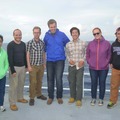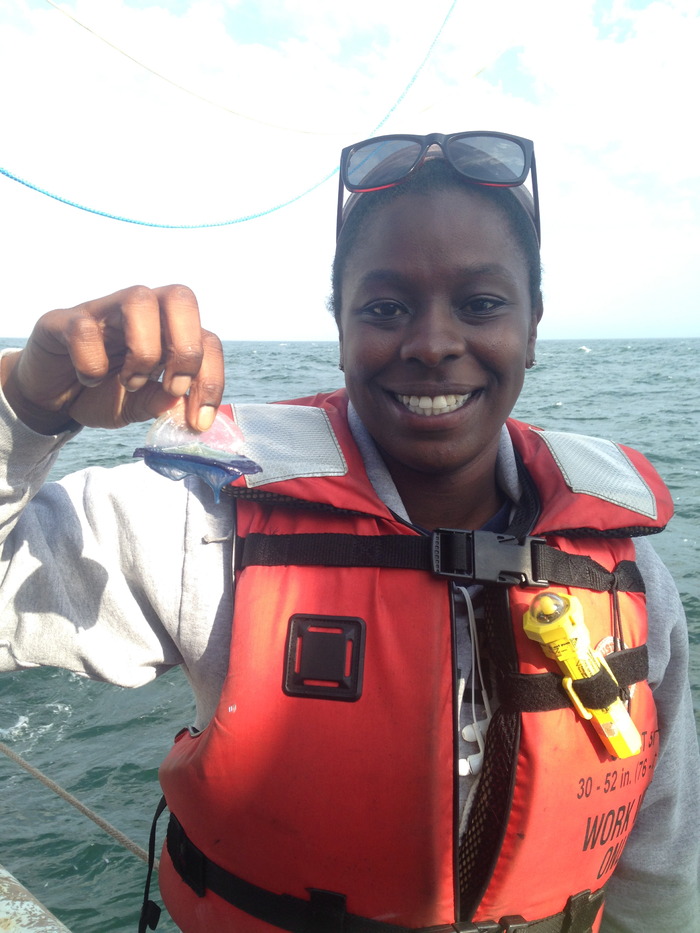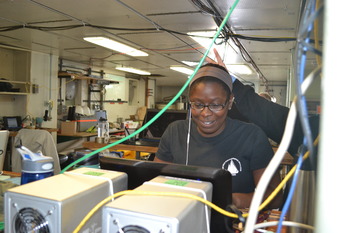10 August 2014
Today is my last full day on the R/V Thompson. We started steaming toward Newport at noon today and the plan is to be there by 2 PM tomorrow. Most people are spending transit working on projects while others are bed due to sea sickness. With the help of John Delaney, fellow students, and some of the engineers on board, I have so many great ideas on where to take my book. I look forward to working with John in the future and am hoping to have a finished project by December. I want to say thank you to John Delaney and Deborah Kelley for the opportunity to be a part of the Visions’14 expedition, it was amazing! So, since this is my last post I just want to thank everyone at home that has been following us online. Stay classy everyone and I hope you all continue to follow the Visions expedition.
8/9 August 2014
Over the last few days a lot has happened. The deep profiler mooring was removed from the bottom of the ocean. Once on board it was fixed and placed back on the seafloor. We just received permission from NSF to plug into the primary infrastructure which made everyone on board happy and was an emotional event for John Delaney (Chief Scientist), as he has been waiting 18 months for permission to plug in. Being on the Thomas G. Thompson has been a rewarding experience and it was amazing to be able to celebrate the plugging in of the system with everyone. It will be nice when the entire system is plugged in and ready to go. On August 10 we will be transiting back to Newport. It’s very sad knowing that the cruise is almost over. I wish that I didn’t have to go back to land and that I could stay on the boat until they finish in October, but I have to go back to work and responsibilities. There’s only a day and a half left until we are back in Newport, so until next time, Stay classy internet viewers.
7 August 2014
Over the last two days Isaac and I have only had one half an hour shift in the ROPOS control room. It was pretty nice since I was able to get a lot of video stuff accomplished. On the 6th we put the Deep Water Profiler in the water along with the HPIES. Once we got the profiler into the water we ran across a pretty big problem: we couldn’t get the cable to plug into the docking station. After deliberation it was decided that the mooring and profiler would be removed from the water and the engineers will hopefully fix the issue and we’ll redeploy it on the 8th.
I’ve made a lot of progress on my project and am really excited to start piecing everything together and getting this video made. Since there hasn’t been much in the way of ROPOS shifts it has given all us students the chance to bond and have some fun. Everyone on this boat has taught me something and I am so grateful to have had this opportunity. Biology friends=friends for life! I truly do believe that the connections you make on these cruises do last a lifetime and I am looking forward to working with everyone again at some point in the future. Until next time, stay classy internet viewers.
5 August 2014
Last night Isaac and I had descent in the ROPOS control room during our 8pm-12am shift. During the descent we saw a squid, multiple dinner plate jellyfish, a few big red jellyfish, and many Euphausids. Once on the bottom we installed the junction box LJ03A and connected it to the low-voltage junction box LV03A. While connecting the two junction boxes, I saw many sea pigs, sea cucumbers, and what looked to be thousands of sea stars. After the junction boxes were connected ROPOS conducted a survey to determine where to set down ROCLS and lay the AXWMV4 cable that the Deep Water Profiler is going to attach to. ROPOS brought ROCLS down to the bottom today to lay the cable and I believe that the Profiler is going to be attached tomorrow.
Today we had a lecture from Dr. Kendra Daly a Biological Oceanographer from the University of South Florida. She spoke to us about the Deep Water Horizon Oil Spill and the impacts that it had on the organisms that live there, especially the plankton populations. Other than the lecture all I did today was work on the script for my video and spent time watching ROCLS lay cable on the bottom of the seafloor. Until next time, stay classy internet viewers.
4 August 2014
Last night Isaac and I had bottom time and a little bit of ascent while on our 8pm-12am shift in the ROPOS control room. While on shift we saw ROPOS destroy a beautiful Ctenophore/polychaete worm. We’re unsure of what it was due to not getting the best look at it. One minute you saw it and the next you see shreds coming from the thrusters. That little guy was not having a good day. Once ROPOS reached the bottom we unlatched from junction box LJ01A and connected the cable from LJ01A to the J5 plug on LV01A.
Today, we had a very interesting lecture on Deep Water Profilers which we will be placing in the water in a couple days. Tim, the ocean engineer on board gave the lecture and explained how the profilers work and all the different components that go in to it. The engineering behind all the instruments that are being deployed is really interesting. Besides that I’ve been working on getting my script together for my video project and narrowing down dive footage and photos to use. Until next time, stay classy internet viewers.
3 August 2014
After a 10 hour delay yesterday ROPOS finally went into the water about an hour before my shift started. Spending time in the ROPOS control room is pretty cool, especially with all the screens. It makes me feel like I’m a part of mission control at NASA. Getting the opportunity to watch ROPOS descend through the water column and seeing many organisms that I’ve never seen in real life before (outside of an aquarium) is pretty exciting. The only down side is that the biologist in me is more interested in all the organisms that we’re seeing than in the laying of the cables and junction boxes. This is terrible because I find everything that we’re doing to be incredibly amazing, but every time I see anything biological my mind wants to drop everything and focus on that. I’ve definitely had a few “ooo squirrel” moments during my shifts.
Having the opportunity to help out the National Science Foundation Ocean Observatories Initiative (NSF OOI) is incredible. What we’re doing here is going to allow us to study the ocean from an entirely new perspective, from within. The best part about this initiative is that it’s not just for scientists, but also for the general public. I’m looking forward to seeing the completed project and updating everyone along the way. So, until next time, stay classy internet viewers.
2 August 2014
Last night I had my first shift in the Remotely-Operated Platform for Ocean Science (ROPOS) control room. During my shift our mission was to take a secondary node junction box (LV01A) to the seafloor. This junction box will serve as a connector for the cable (RS01W6) that’s going to be laid tomorrow using the Remote-Operated Cable Laying System (ROCLS). While descending we saw a large school of fish that stayed with ROPOS for almost 800 meters, and also saw multiple jellyfish and crustaceans.
The day went by a little slow and other than a whale that was spotted off the port bow not much excitement occurred. My new friend Madison and I realized the difficulty that comes with working out on a moving boat especially when the boat is in uneven seas. I look forward to all the excitement that’s to come, so until next time, stay classy internet viewers.
1 August 2014
The steam out of Newport was smoother than anticipated. As we’re steaming out, the waves are getting larger in size and the boat is feeling like a small roller coaster. As the rocking increased I noticed a few students’ faces begin to turn pale and some even looked a little green. I’m fortunate to be one of the few that do not get sea sick, but I am feeling bad for the ones that do. Besides all the sea sickness that’s occurring, I’ve seen a lot of fascinating things while on board. Off the starboard side of the ship I saw a few whales and an adorable baby Mola mola (sunfish). Off the aft of the ship, I also saw a few thousand Velella velella (jellyfish). It’s been amazing seeing all this stuff in real life instead of just reading about it or seeing it on Blue Planet. Besides the organisms the people on board are pretty awesome! There is a lot of knowledge on this vessel and I look forward to learning something new from everyone. So, until next time, stay classy internet viewers ?




